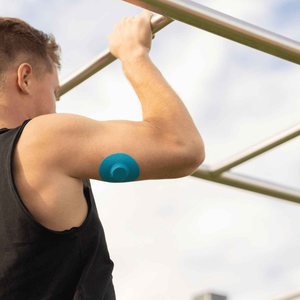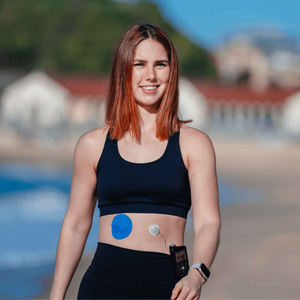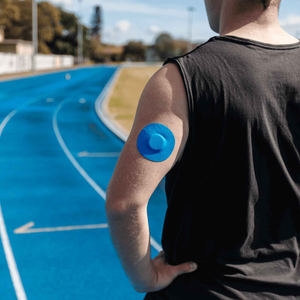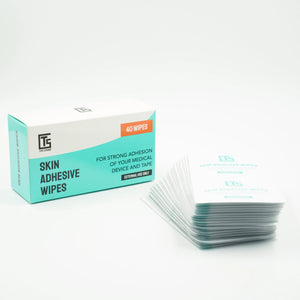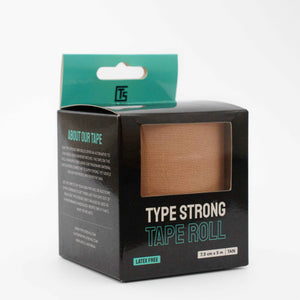Diet soft drinks promise sweetness without sugar. For people managing diabetes, they often feel like the safest choice – no calories, no glucose spikes on your CGM. But recent evidence suggests that over time, artificial sweeteners may have subtle effects on your body. Could diet sodas influence insulin sensitivity, cravings, or gut health in ways that aren’t obvious?
Disclaimer: This article is for educational purposes only and is not medical advice. Always speak with your healthcare professional before making changes to your diet or diabetes care.
Why diet soft drinks seem blood-sugar friendly
Diet sodas replace sugar with non-sugar sweeteners such as aspartame, sucralose, or acesulfame potassium. Because these compounds are not metabolised into glucose, they typically do not cause the sharp rises in blood sugar that regular soft drinks do (NHS, 2023).
This is why your CGM often shows a “flat line” after diet soda compared with the rapid spike from regular cola. The American Diabetes Association (2024) recognises that non-nutritive sweeteners can help reduce added sugar, but cautions that overall diet quality matters most.
What sweeteners are actually in diet drinks?
Not all sugar-free drinks are created equal. Each uses different sweeteners and flavour bases, which can influence both taste and how your body responds over time.
|
Drink (common varieties) |
Main sweeteners (region may vary) |
Notes |
|
Diet Coke |
Aspartame |
Uses citric acid for tartness; lighter, distinct taste from Coke Zero. |
|
Coke Zero / Coke No Sugar |
Aspartame + Acesulfame potassium (acesulfame-K) |
Includes potassium citrate instead of citric acid; designed to taste closer to classic Coca-Cola. |
|
Pepsi Max |
Aspartame + Acesulfame-K |
Stronger cola flavour than Diet Pepsi. |
|
Diet Pepsi |
Aspartame |
Uses citric acid for tang; simpler sweetness profile. |
|
Sprite Zero |
Aspartame + Acesulfame-K |
Citrus blend; similar formulation to Coke Zero. |
|
Fanta Zero |
Aspartame + Acesulfame-K |
Common mix across fruit-flavoured zero sodas. |
|
Sugar-free energy drinks (e.g. Red Bull Sugarfree, Monster Zero Ultra) |
Sucralose + Acesulfame-K |
Combine sweeteners with caffeine and flavour additives. |
Note: Ingredients may vary by country due to regional regulations. Data verified from The Coca-Cola Company (2023) and Taste of Home (2024).
Coke Zero vs Diet Coke what’s the real difference?
Many people assume Coke Zero and Coke No Sugar are different products. In reality, they’re almost identical in both ingredients and taste. The main variation comes down to branding and regional naming.
According to The Coca-Cola Company (2023) and Taste of Home (2024):
- Coke Zero Sugar (sold as Coke No Sugar in some countries) contains aspartame and acesulfame potassium (acesulfame-K) as its sweeteners.
- It uses potassium citrate instead of citric acid to reduce acidity.
- Diet Coke uses only aspartame and citric acid, creating a lighter, tangier flavour profile.
- Coke Zero and Coke No Sugar are formulated to taste closer to Coca-Cola Classic, while Diet Coke stands apart as its own recipe.
From a blood sugar perspective, all three are similar – they do not contain glucose and therefore don’t cause immediate CGM spikes. However, long-term metabolic effects depend on factors such as insulin sensitivity, gut microbiota, and appetite response.

What research suggests about long-term risk
Short-term CGM data may look reassuring, but research highlights possible indirect effects over time:
- Gut microbiome changes. Sweeteners such as sucralose and saccharin can alter gut bacteria, which may affect glucose tolerance (Suez et al., 2014).
- Insulin sensitivity. Repeated exposure may reduce how effectively insulin works, leading to more variable glucose readings (Romo-Romo et al., 2018).
- Cravings and appetite. Sweeteners maintain a preference for highly sweet flavours, sometimes leading to overeating later (Sylvetsky et al., 2016).
- Type 2 diabetes risk. Large cohort studies link frequent consumption of artificially sweetened drinks with a higher risk of type 2 diabetes (Debras et al., 2023).
The World Health Organization (2023) now advises against using non-sugar sweeteners for weight control due to limited long-term benefit.
Regular vs diet soft drinks
|
Feature |
Regular soft drinks |
Diet soft drinks |
|
Sugar content |
20–40g per can |
0g |
|
Immediate glucose effect |
Sharp spike |
Minimal direct impact |
|
Insulin response |
Strong rise |
Possible indirect effects |
|
Gut microbiome |
Disrupted by high sugar |
Altered by some sweeteners |
|
Appetite |
Reinforces sweet preference |
May maintain cravings |
|
Long-term risk |
Obesity, type 2 diabetes |
Insulin resistance (mixed evidence) |
People also ask
Do diet soft drinks raise blood sugar?
Not directly. They do not contain glucose, so CGM readings typically remain stable. However, research continues into indirect effects on insulin sensitivity (WHO, 2023).
Can diet soda make diabetes worse?
Not immediately, but heavy long-term use has been associated with higher rates of insulin resistance and type 2 diabetes (Debras et al., 2023).
Are diet drinks better than sugary drinks?
Yes, they avoid sharp spikes, but frequent consumption may affect cravings and gut health. Water, sparkling water, and unsweetened tea are better daily choices.
What your CGM can show you
Your CGM helps reveal your personal response to diet drinks. While most users see flat glucose lines immediately after drinking them, delayed changes can occur if cravings trigger extra snacking later.

For accurate readings, patch security matters. Reliable CGM patches help maintain stable sensors even during heat, sweat, or exercise.
Recommended support tools:
- Dexcom G7 patches for active users
- Omnipod patches for pump wearers
- Adhesive wipes for better adhesion and edge protection
Helpful reads for improving wear time and skin comfort:
- How to prep your skin for patches
- 5 signs your CGM patch is too weak
- Post-adhesive skin care after CGM removal
Smarter swaps for hydration
Instead of relying on diet sodas, try:
- Sparkling water with citrus or berries
- Herbal or green tea (hot or iced)
- Water infused with cucumber or mint
- Unsweetened iced coffee
These options hydrate effectively and avoid both sugar and artificial additives.
Final thoughts
Diet soft drinks aren’t as simple as “good” or “bad.” They avoid glucose spikes but may influence long-term insulin response, cravings, and gut balance.
Your CGM allows you to explore how your own body responds. With secure patch support, you can test drinks safely and keep your readings reliable. Moderation, variety, and awareness make the biggest difference to blood sugar stability.
References
- American Diabetes Association (2024). Standards of Medical Care in Diabetes – 2024. Diabetes Care, 47(Supplement_1), S1–S166. doi:10.2337/dc24-Sint.
- Debras, C. et al. (2023). Artificial sweeteners and risk of type 2 diabetes: results from the NutriNet-Santé cohort. Diabetes Care, 46(9), pp.1681–1689.
- National Health Service (2023). Are sweeteners safe for children? Available at: https://www.nhs.uk/live-well/eat-well/are-sweeteners-safe-for-children/ (Accessed: 24 September 2025).
- Romo-Romo, A. et al. (2018). Sucralose decreases insulin sensitivity in healthy subjects. Journal of Clinical Nutrition, 107(3), pp.479–485.
- Suez, J., Korem, T., Zilberman-Schapira, G., Segal, E. and Elinav, E. (2014). Artificial sweeteners induce glucose intolerance by altering the gut microbiota. Nature, 514(7521), pp.181–186.
- Sylvetsky, A.C., Rother, K.I. and Brown, R.J. (2016). Artificial sweetener use among children: epidemiology, recommendations, metabolic outcomes, and future directions. Pediatric Clinics of North America, 64(6), pp.1469–1480.
- Taste of Home (2024). Coke Zero vs Diet Coke: What’s the Difference? Available at: https://www.tasteofhome.com/article/coke-zero-vs-diet-coke/ (Accessed: 10 October 2025).
- The Coca-Cola Company (2023). Coca-Cola Zero Sugar and Diet Coke ingredient listings. Available at: https://www.coca-cola.com/ (Accessed: 10 October 2025).
- World Health Organization (2023). Use of non-sugar sweeteners: WHO guideline. Geneva: WHO.
